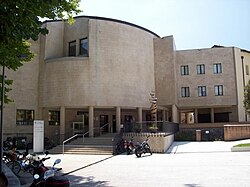
Friuli-Venezia Giulia is one of the 20 regions of Italy and one of five autonomous regions with special statute. The regional capital is Trieste on the Gulf of Trieste, a bay of the Adriatic Sea.

Friuli is a historical region of northeast Italy. The region is marked by its separate regional and ethnic identity predominantly tied to the Friulians, who speak the Friulian language. It comprises the major part of the autonomous region Friuli-Venezia Giulia, i.e. the administrative provinces of Udine, Pordenone, and Gorizia, excluding Trieste.

The provinces of Italy are the second-level administrative divisions of the Italian Republic, on an intermediate level between a municipality and a region. Since 2015, provinces have been classified as "institutional bodies of second level".

Northeast Italy is one of the five official statistical regions of Italy used by the National Institute of Statistics (ISTAT), a first level NUTS region and a European Parliament constituency. Northeast encompasses four of the country's 20 regions:
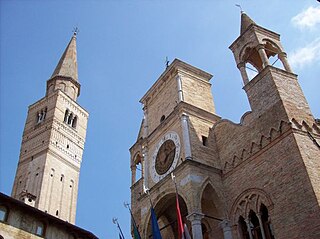
Pordenone is a city and comune (municipality) in the Italian region of Friuli-Venezia Giulia, the capital of the Regional decentralization entity of Pordenone.

The province of Gorizia was a province in the autonomous Friuli-Venezia Giulia region of Italy. Initially disbanded on 30 September 2017, it was reestablished in 2019 as the regional decentralization entity of Gorizia, and was reactivated on 1 July 2020.

The province of Trieste is a province in the autonomous Friuli-Venezia Giulia region of Italy. Its capital was the city of Trieste. It had an area of 212 square kilometres (82 sq mi) and it had a total population of 234,668. It had a coastal length of 48.1 kilometres (29.9 mi). Abolished in 2017, it was reestablished in 2019 as the regional decentralization entity of Trieste, and was reactivated on 1 July 2020.

The province of Udine was a province in the autonomous Friuli-Venezia Giulia region of Italy, bordering Austria and Slovenia, with the capital in the city of Udine. Abolished on 30 September 2017, it was reestablished in 2019 as the Regional Decentralization Entity of Udine, and was reactivated on 1 July 2020. It has a population of 530,849 inhabitants over an area of 4,907.24 square kilometres (1,894.70 sq mi).

The Julian March, also called Julian Venetia, is an area of southern Central Europe which is currently divided among Croatia, Italy, and Slovenia. The term was coined in 1863 by the Italian linguist Graziadio Isaia Ascoli, a native of the area, to demonstrate that the Austrian Littoral, Veneto, Friuli, and Trentino shared a common Italian linguistic identity. Ascoli emphasized the Augustan partition of Roman Italy at the beginning of the Empire, when Venetia et Histria was Regio X.

The flag of Friuli is the official standard of historical Friuli. A Friuli-Venezia Giulia Autonomous Regional law describes the flag as consisting of "…a rectangular standard featuring at its centre a golden heraldic eagle with outspread wings, headturned to the left, open beak and red claws, set in a sky blue field. The crest covers three fifths of the height of the flag, which in turn is two thirds of its length."
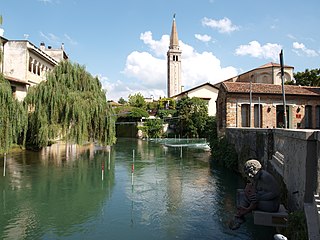
Sacile is a comune (municipality) in the Regional decentralization entity of Pordenone, in the Italian region of Friuli-Venezia Giulia. It is known as the "Garden of the Serenissima" after the many palaces that were constructed along the river Livenza for the nobility of the Most Serene Republic of Venice.

The Triveneto or Tre Venezie, also often referred to as North-Eastern Italy or simply North-East, is a historical region of Italy. The area is made up of the three smaller historical regions of Venezia Euganea, Venezia Giulia and Venezia Tridentina. This territory was named after the Roman region of Venetia et Histria.

Sappada is a comune (municipality) in the Regional decentralization entity of Udine, in the Italian region of Friuli-Venezia Giulia. It is one of I Borghi più belli d'Italia.

Codroipo is a comune (municipality) in the Regional decentralization entity of Udine, in the Italian region of Friuli-Venezia Giulia, located about 70 kilometres (43 mi) northwest of Trieste and about 20 kilometres (12 mi) southwest of Udine.

Casarsa della Delizia or simply Casarsa is a comune (municipality) in the Regional decentralization entity of Pordenone in the Italian region of Friuli-Venezia Giulia, located about 80 kilometres (50 mi) northwest of Trieste and about 15 kilometres (9 mi) east of Pordenone.
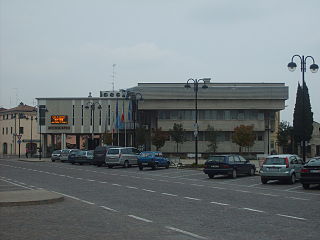
Cordenons is a comune (municipality) in the Regional decentralization entity of Pordenone in the Italian region of Friuli-Venezia Giulia, located about 90 kilometres (56 mi) northwest of Trieste and about 4 kilometres (2.5 mi) northeast of Pordenone. As of 31 December 2004, it had a population of 17,738 and an area of 56.8 square kilometres (21.9 sq mi).

Pordenone railway station serves the city and comune of Pordenone, in the autonomous region of Friuli-Venezia Giulia, northeastern Italy. Opened in 1855, the station is located on the Venice–Udine railway. Although it is not a junction or terminal station, it is used by a great many passengers.
Monfalcone railway station serves the town and comune of Monfalcone, in the autonomous region of Friuli-Venezia Giulia, northeastern Italy.
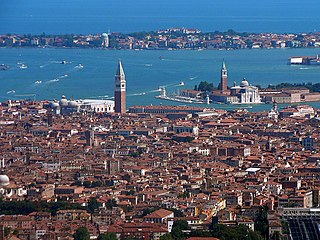
The Metropolitan City of Venice is a metropolitan city in the Veneto region of Italy, one of ten metropolitan cities in Italy. Its capital is the city of Venice. It replaced the province of Venice in 2015 and includes the city of Venice and 43 comuni. It was first created by the reform of local authorities and then established by Law 56/2014.

Miramare railway station is a railway station in Miramare, a suburb of Trieste, in the autonomous region of Friuli-Venezia Giulia, northeastern Italy. The station was constructed in 1857 on a line which at the time connected Vienna with Trieste. The purpose of the new station was mainly to serve the Miramare Castle, newly constructed residence of the Archduke Maximilian. The station building is intact but it is closed, and only local trains to Udine stop at the station.
